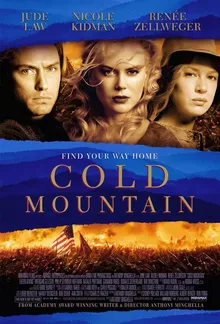Historical accuracy of Cold Mountain

Historical accuracy of Cold Mountain

Characters
W. P. Inman (Jude Law)
Inspired by the author's ancestor, William P. Inman of the 25th NC Infantry, who was wounded and likely did desert/return home. However, the epic journey and specific encounters are fictionalized.
Ada Monroe (Nicole Kidman)
A fictional character representing educated, upper-class women unprepared for the hardships of rural life when left alone by the war.
Ruby Thewes (Renée Zellweger)
A fictional character embodying resilience, practicality, and deep knowledge of Appalachian survival skills.
Teague (Ray Winstone)
While a specific character, Teague represents the documented brutality and abuse of power exhibited by some real Confederate Home Guard units in areas like Western North Carolina, hunting deserters and terrorizing civilians.
Reverend Monroe (Donald Sutherland)
Fictional character setting up Ada's situation.
Stobrod Thewes (Brendan Gleeson)
Fictional character, representing outliers and musicians caught up in the war's periphery. (Gleeson did his own fiddling).
More characters
Reverend Veasey (Philip Seymour Hoffman)
Fictional character representing the morally complex or fallen figures Inman meets on his journey.
Sally Swanger (Kathy Baker)
Fictional character representing the women holding together the community on the home front.
Bosie (Charlie Hunnam)
Fictional member of Teague's Home Guard posse.
Georgia (Jack White)
Fictional character involved in a musical subplot.
Story
Battle of the Crater (Petersburg, VA - July 1864)
The film opens with a graphic and well-regarded depiction of this historical battle's chaos and brutality. Some details are inaccurate (size of crater, absence of US Colored Troops, specific units involved).
High rates of Confederate desertion late in the war
Widespread desertion, especially among North Carolina troops, was a major issue for the Confederacy due to war weariness, hardship, and concern for families. Inman's desertion reflects this.
Existence and role of Confederate Home Guard
The Home Guard was real, tasked with policing the home front, enforcing conscription, and pursuing deserters.
Brutality and abuses by some Home Guard units
While not all were like Teague's band, historical accounts confirm that some Home Guard units, particularly in divided areas like Appalachia, acted with extreme brutality and extra-legally.
Hardships faced by civilians (especially women) on home front
Accurately portrays the scarcity, loneliness, hard labor, and vulnerability to violence faced by women and families left behind in the rural Confederacy.
Life in Appalachian North Carolina during the Civil War
Reflects the isolation, internal conflicts (though Unionism understated), reliance on subsistence farming, and the impact of the war on mountain communities.
Inman's specific journey and encounters
The detailed odyssey of Inman from Virginia to Cold Mountain, including specific people met and events, is a fictional narrative based on the novel, not a documented historical trek.
Inman's route (going east to coast before heading west)
Geographically illogical for a deserter traveling from Petersburg, VA, to Western NC. Coastal areas were largely Union-controlled.
Downplaying/omission of slavery as a central issue
The film, like the novel, is criticized for largely avoiding the issue of slavery, which was central to the Confederacy and the war, even in mountain regions. This is seen as a significant historical simplification.
Killing of outliers/deserters by Home Guard
The summary execution or murder of suspected deserters and Union sympathizers by Home Guard units is documented in historical accounts from the region.
Setting
Appalachian North Carolina (Civil War era)
Captures the rugged beauty and isolation, but primarily filmed in Romania. While visually stunning, it may not perfectly replicate the specific flora and topography of the Blue Ridge Mountains.
Battle of the Crater battlefield (Petersburg, VA)
The opening scenes effectively convey the grim reality of trench warfare and the catastrophic explosion.
Rural farms, cabins, and small settlements
Accurately reflects the architecture and living conditions of the period in the rural Appalachian South.
Costumes (Civilian and Military)
Costumes are generally well-researched, showing appropriate civilian wear for different social classes and realistic, often worn Confederate uniforms reflecting late-war conditions.
Weaponry
Depicts common Civil War firearms. Some inaccuracies noted, such as the relatively widespread use of advanced Spencer repeating carbines by Home Guard members and civilians, which would have been unlikely.
Wilderness terrain during Inman's journey
Effectively portrays the natural environment as both beautiful and perilous, a significant factor in Inman's trek.
Period atmosphere (Hardship, War Weariness, Violence)
Successfully conveys the overall mood of the later stages of the Civil War in the Confederacy – the suffering, division, desperation, and pervasive violence affecting soldiers and civilians alike.
Use of period music / folk traditions
Incorporates authentic Appalachian folk music and traditions (like shape-note singing), enhancing the period setting and cultural context.
